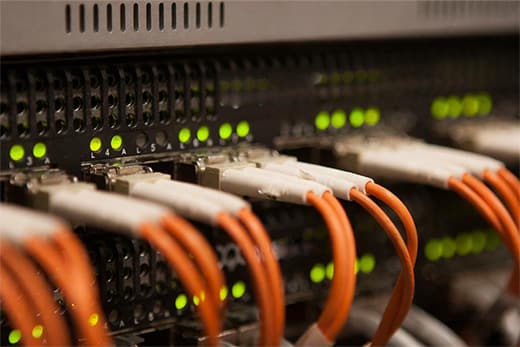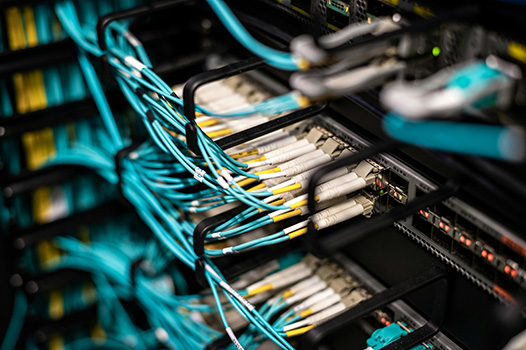Is your campus infrastructure ready for the demands of Wi-Fi 7 and the future of smart education?
The start of a new semester. For the campus, it's a vibrant return to life. For the IT department, it's often the beginning of an annual nightmare.
This was the reality for the IT team at the University of Nigeria, whose "Lionet" network ground to a halt under the strain of returning students, flooding the helpdesk with complaints of poor signal, packet loss, and excruciatingly slow downloads. It’s a story that echoes across student forums worldwide: students debating whether their Wi-Fi speed is measured in "bits or bytes," with many forced to rely on their expensive 5G hotspots just to attend online classes.
If this sounds painfully familiar, the problem runs deeper than your Wi-Fi access points. The real bottleneck is often hidden in plain sight: your campus core network backbone.
The Problem: Moving Beyond Surface-Level Fixes
Many campus networks were built on a 1G or 10G backbone, which was adequate for the era of email and basic web browsing. But today, we face a data tsunami driven by:
- High-Density Devices: Every student brings a laptop, a smartphone, and a tablet.
- Bandwidth-Hungry Applications: 4K/8K video streaming, interactive online courses, and cloud collaboration platforms are now standard.
- The Future on the Horizon: The widespread adoption of Wi-Fi 6/6E, and the imminent arrival of Wi-Fi 7, will push wireless access speeds toward the 10Gbps mark. Simultaneously, a vast ecosystem of smart campus IoT devices continues to stream data 24/7.
When traffic from thousands of high-speed wireless lanes tries to merge onto a single, narrow 10G backbone, congestion is inevitable. A "100G backbone with 10G to the room" is quickly becoming the new benchmark for a modern, competitive institution. This isn't just a trend; it's a necessity. According to industry analyst firm Dell’Oro Group, the demand for 25G and 100G ports in campus environments is rising significantly, driven by Wi-Fi 7 and higher-capacity backbone upgrades. Keeping pace with this technological shift is critical to protecting your university's IT investment.
The Blueprint: Architecting a Future-Ready Network
To fundamentally solve the problem, a modern, three-tier network architecture is required.

This architecture creates a non-blocking, high-capacity core by establishing a clear hierarchy:
Core Layer: The high-speed heart of the network, using redundant links (e.g., 100G) to ensure maximum uptime and performance.
Aggregation Layer: Connects different campus zones—academic buildings, libraries, dormitories—and consolidates their traffic before sending it to the core.
Access Layer: The edge of the network where end-user devices like Wi-Fi APs, PCs, and IoT devices connect.
The goal is to ensure that data traffic from any point on the network can be forwarded with speed and stability, empowering the entire campus.
The Axonode Engine: Powering the Data Superhighway
So, how do you light up this 100G data superhighway? The answer lies in the small but mighty components that form the physical links: high-performance optical transceivers.
Without stable, reliable optical modules creating the light paths between switches, even the most powerful hardware remains a collection of isolated islands. This is where Axonode plays its central role.
For the critical backbone links in your upgraded network, you need:
- Axonode's 100G QSFP28 Transceiver Family
Application: Ideal for interconnecting core switches and linking the core to critical aggregation zones. Our 100GBASE-LR4 modules support distances up to 10km, perfectly suited for connecting buildings across a large campus
- Axonode's 40G QSFP+ Transceiver Family
Application: A highly cost-effective solution for connecting the aggregation layer to high-density access areas like libraries and large dormitories, providing ample 40Gbps bandwidth.
We understand the rigorous demands of educational networks for stability, compatibility, and budget-consciousness. Axonode transceivers are rigorously tested to ensure seamless compatibility with leading switch brands like Cisco, Juniper, H3C, and NETGEAR. This allows you to avoid the "vendor premium" and invest your valuable educational budget where it matters most.
The Transformation: From "Working" to "Thriving"
A successful backbone upgrade delivers a transformational leap for your campus:
- A Seamless User Experience: No more video buffering or lagging online classes. Thousands of faculty and students can enjoy a smooth, high-performance network, even during peak hours.
- Empowered Research: Provide stable, high-speed data transport for labs and research centers handling massive datasets, accelerating innovation.
- Future-Proofed for Tomorrow: Secure the bandwidth needed for Wi-Fi 7, VR/AR learning, and campus-wide IoT applications, ensuring your network remains relevant for the next 5-10 years.
- Simplified IT Operations: A rock-solid physical layer frees your IT team from constant firefighting, allowing them to focus on higher-value network optimization and security initiatives.
Start Your Network Upgrade Plan Today
It's time your campus network matched your university's reputation. Don't wait for the next "back-to-school" network nightmare.
Contact Our Solutions Experts for a complimentary campus network upgrade assessment.

 A Deep Dive into High-Speed Data Center Interconnects: A Field Guide for Engineers on DACs, AOCs & Optical Transceivers
A Deep Dive into High-Speed Data Center Interconnects: A Field Guide for Engineers on DACs, AOCs & Optical Transceivers
 The Ultimate "In-Rack" Showdown: DAC vs. Transceivers vs. AOCs
The Ultimate "In-Rack" Showdown: DAC vs. Transceivers vs. AOCs
 Fiber Exhaustion? The WISP & MSP's Field Guide to Passive CWDM Expansion
Fiber Exhaustion? The WISP & MSP's Field Guide to Passive CWDM Expansion

